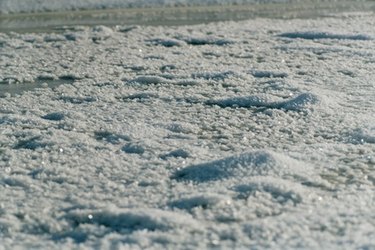
While rock salt and urea both have considerable ice melting power, the decision to use one over the other is dependent upon your personal circumstances. Both have environmental drawbacks as rock salt damages both flora and fauna but urea performs poorly when temperatures dip below 21 degrees Fahrenheit.
Types
Video of the Day
The term rock salt is broad, covering a range of products that include sodium chloride, potassium chloride, magnesium chloride and calcium chloride. Urea refers to a commercially produced product often utilized as a fertilizer.
Video of the Day
Environmental Impact
While rock salt can be detrimental to the health of grass and flowers, urea acts as a fertilizer. It boosts plant growth and productivity by providing needed nitrogen to the roots. However, in urban settings, water runoff can carry much of that urea into the storm drain system. The nitrogen in urea will eventually end up in waterways, where it can cause a chemical imbalance and endanger the water source's ecosystem.
Child Safety
Rock salt is not the same as table salt. It is a poisonous substance that should be kept out of reach of small children. Salt can be carried into a dwelling on the bottoms of shoes, so check treads in addition to properly storing rock salt supplies.
Effect on Pets
Most domestic animals are sensitive to the various forms of rock salt. In addition to harm from ingesting these chemicals, the products can cause serious irritation to their paws. Urea is a safer alternative for households with dogs or cats.
Performance
Rock salt and urea both have significant ice melting capabilities. However, when the temperatures are extremely frigid, urea is ineffective. Many people choose to alternate their use based upon the temperature.
Cost
Rock salt is inexpensive, averaging about $5 for a 40 lb. bag. Urea is more costly, selling for about $25 for the same size bag.